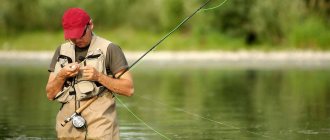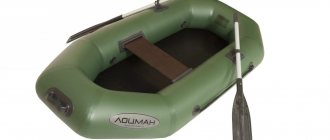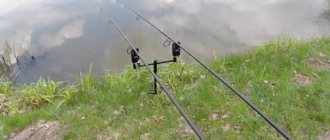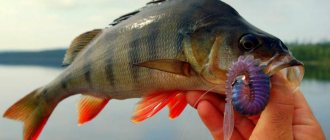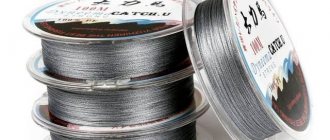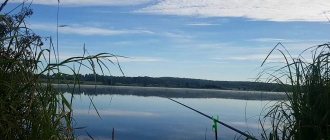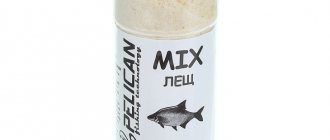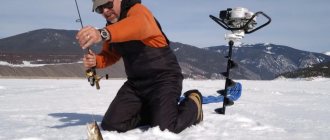Many years ago I was surprised by what I saw when I was on holiday in the countryside. Several men, avid fishermen who lived in a small village from the city, took a good catch from the river every evening.
These were large perches, squints and sometimes roaches. And there’s a whole backpack of these pretty village crucians! And what’s most interesting is that when I stood next to them, I took out one small thing. Or he might not have caught anything at all. I became curious why this was the case.
Why do local avid fishermen catch so successfully, what is their secret?
My friend and I decided to meet men. And I noticed that their fishing “devices” were far from modern and generally looked kind of cheap.
The fishing rods are rough and massive, probably from the times of the USSR. The fishing line, if my memory serves me right, is about 0.3mm thick, which is quite a lot. Hand made float. It seems even from a traffic jam. Well, the size of the hook is large.
But surprisingly, none of this bothered them. They caught great fish. For example, experienced fishermen could catch up to ten perches and other fish at a time. And what’s surprising is that this is even without bait and other modern means.
They did everything the old fashioned way. Before fishing, we went into an abandoned barn, rickety from time to time, and dug for dung worms there. By the way, my friend and I were digging in the same place. I wanted to do as much as possible the same as they did. But the result was not as expected.
And then we had questions to which we did not know the answers. How do they manage to fish so well? Why are we worse and what are we doing wrong?
Unfortunately, our vacation was already coming to an end. And we started fussing, because it was very interesting what the secret of such fishing was. And I didn’t want to go empty-handed.
Useful and interesting: Excellent catch on small forest taiga rivers!
Selecting a location
The quantity and quality of the catch depends on the area. Some reservoirs may be too polluted and inhabited only by low-value fish species. Others are already occupied by fishermen. Still others are the property of a fish hatchery or tourist center, and fishing on them is prohibited. But in any case, there are always options, you just have to study them carefully.
Fishing camps
Roads near big cities are full of all kinds of signs: LLC “Bolshoi Ulov”, “Surf”, “Fishing”, etc. For a reasonable price they provide a number of services: access to a reservoir, a house, a barbecue, firewood, a bicycle, and sometimes even a horse ride a walk if the camp site has a stable. This way you can easily organize leisure time for the whole family.
A separate advantage I would like to note is the cleanliness and quality of the reservoirs. There will be no vegetation around them, and therefore no waterfowl. The reservoirs themselves are intensively stocked with valuable species of fish: from carp to trout, and the fish themselves will be healthy and fattened.
As a rule, there are two payment options - daily or payment for caught fish.
Not all fishermen like this type of recreation. Some argue that in this case the essence of fishing is lost; there is no fishing excitement that arises when catching a wild predator. If you are one of them, consider the following option.
The secret of seasoned experienced fishermen, how to leave the river with a rich catch
Fortunately, there are always discoveries and kind people in the villages. They will always help if possible. And lo and behold, experienced fishermen invited us to their place. This was such a chance, and it was stupid to miss it.
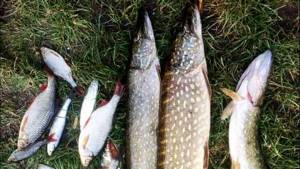
We made tea over the fire the old fashioned way. It was a beautiful summer evening. One of the “professionals” offered to sit in his place. There were all the same fishing rods and the same dung worm. And how I immediately felt strength in my hands! It was a big fish! After some time, the secret of the catch turned out to be simple.
Let's start from afar. Everyone is celebrating New Year. And everyone should have a beautiful, elegant Christmas tree. Only after this holiday do not rush to throw away this beauty. Why?
Yes, because in March or April you need to choose a deep place in a pond or river. Tie something heavy to this dried tree, for example, several bricks. And let you fall into this deep hole.
Somewhere in June, small bugs and insects that fish love so much will live there. And by throwing a fishing rod into this hole, you can catch a good and successful catch.
I will say more, I have been using this method for more than a year, and it has never let me down. In the fall or spring, I throw dried branches into the checked places and you are guaranteed pleasant fishing.
Be sure to try this and you will see that there will be much more fish when fishing!
I recommend watching: Three cunning and catchy DIY fishing crafts from Soviet times!
Features of catching fish on a fishing rod with a float
Fishing with a float rod has its own techniques and features. The depth of casting the tackle should not exceed 2-3 m. It must be taken into account that the distance of casting bait is inversely proportional to the depth parameters. When fishing with a float rod, it is important to know which species are being hunted in water.
If it is carp, crucian carp, bream or perch, then the tackle is cast to great depths (the listed fish species live close to the bottom of the reservoir).
Rudds, bleaks, and perch, on the contrary, swim close to the surface of the water, so you can catch them by placing the float as close to the hook as possible. This parameter must be adjusted in accordance with the fishing characteristics by moving the float down or up the line. The further it is removed from the hook, the greater the fishing depth will be. For example, if the distance from the float to the hook is 1 m, then fishing is carried out using a float rod with a depth of 1 m from the surface of the water.
Choosing the optimal technique for fishing with a float rod requires taking into account the following parameters:
- searching for a suitable area and calculating the optimal depth for fishing. There is a special device called an echo sounder, with which the depth of a reservoir can be easily determined. But not every fisherman has the financial means to buy it. Most often, the depth of a reservoir is determined experimentally (for example, using a long stick). As for the bottom topography at the fishing site, it can be determined by analyzing the surface state of the water surface (especially when fishing in the current). If fishing is carried out in a quiet body of water, then a fishing rod is used to determine its depth. The float is placed at the expected depth, and then the gear is thrown into the water. If the float stands well, then it can be moved even higher, thereby increasing the depth. It is necessary to achieve a position where the float lies horizontally on the surface of the water (this will mean that the baited hook has reached the bottom of the reservoir). After this, you need to reduce the depth by the length of the leash. In this way, it will be possible to ensure that the hook with bait is located near the bottom, and it becomes possible to catch fish living at depth;
- choice of bait. Baits and baits are an essential attribute of successful fishing. The fish is unlikely to covet a bare hook, but if there is animal bait on it (bloodworms, fly larvae, maggots, worms), then the bite will probably be good and frequent. Summer fishing with a float rod is the optimal time to use animal hook baits. During the off-season, it is better to choose vegetable baits (for example, steamed corn, dough, steamed pearl barley). If the bite is bad, you can make a “sandwich” from animal and plant bait (earthworm and maggot, bloodworms and maggot, pearl barley and maggot, corn and maggot);
- lure. When going fishing, take fish bait with you. She lures prey to the fishing spot, making it clear to the inhabitants of the reservoir that it is in this area that they can enjoy a tasty meal. Ready-made bait mixtures for fishing are now sold in specialized stores. Before being thrown into the water, they are mixed with coastal clay and soil. Good bait for fish is made from pearl barley or millet porridge mixed with aromatic ingredients (dill, cake, bran, breadcrumbs). If you are fishing in the current, mix bait with clay and form balls out of it, and then throw them into the water. In this form, it will quickly reach the bottom of the reservoir. To make the fish bite better, throw the main bait along with the groundbait. Do not throw all the bait into the water at once, so as not to overfeed the prey. The effect of using bait appears after 15-20 minutes (provided the fish are fishing in the current).
Remember that the bait mixture is intended to lure fish to the fishing site, and not to feed the prey well. To maximize the effect of its use, add an aromatic substance to the mixture (for example, anise drops, hemp).
Common Mistakes
- Incorrectly selected gear . Beginners love to buy nervous, ringing rods and expensive spinning rods, not realizing that this is not appropriate in all places. Fish, most of them, love silence.
- Universal rods will not fit anywhere . You don't have to buy an expensive fishing rod. It is better to buy 2 cheaper ones: heavy and light.
- It is believed that when catching pike perch with a spinning rod, you need its rigidity and power . The main thing when catching this fish is the sensitivity of the spinning rod, its quick reaction to the approach of the pike perch to the bait.
- A thick line does not mean it is reliable . It can be completely insensitive and sluggish bites, for example, of pike perch, can be easily missed, and there will be no catch.
- You need to fish with jigs with a thin line . Thick will negatively affect the nature of the wiring.
- Novice fishermen make mistakes when casting a spinning rod . The technique is difficult to master; casts must be sharp, as the bait flies forward quickly.
- Wiring causes difficulties for beginners . The top of the rod is not fixed correctly when fishing with a spinner. The petal malfunctions and no bites occur. For beginners, it is better to use wobblers; there is no need to attach them to the tip of the spinning rod.
- The amount of complementary feeding must be taken into account depending on the weather , time of year, concentration of fish, and its size.
It will never be superfluous to throw a handful of grains or maggots for the approach of large fish. Please consider if bait was used in this area before your arrival. Maybe this place is already pretty well fed. - Don't stop in one place for more than half an hour if the fish doesn't bite. But, if there were still bites, then you should be patient.
- Do not stand out in the sun or against the sky to avoid shadows on the water. Approach the shore carefully; there should be no outside noise.
- Don’t throw gear unnecessarily.
- to suddenly pull the fish out and drag it through the air.
How to rig a fishing rod
Many anglers prefer two rigging methods: sliding and blind installation. These two types of components are similar in assembly. The only exception is the float, which can be attached in different ways.
Line selection
A monofilament line is a more suitable option for catching fish over 1 kg, since a break may occur at the last moment of fishing. The fish will desperately resist. And the stretchable fishing line will not allow the tackle to break.
Fishing lines are produced in whole series for a specific purpose. For catching heavyweights and fishing in frosty conditions.
Manufacturers began to produce fluorocarbon fishing line to replace monofilament line. This line is more expensive in price. Its most significant advantage is its invisibility in the water. It becomes absolutely invisible to the fish, which increases the likelihood of fishing success. If you don’t have enough money to buy a reel, you can purchase several meters of fluorocarbon fishing line and tie it to the main one.
For match rods, the weight of the line is considered an important factor. Because fishing is carried out at a great distance from the shore and the possible wind can be annoying. Therefore, it is recommended to buy weighted options that float in the water.
When purchasing a braided fishing line, you may encounter the fact that during hooking the fish lip will break. The fish begins to flop around, a hole is formed in the place where the hook is caught and the prey can jump off. There is an important advantage - this is the opportunity to catch a truly massive specimen. Because the fishing line is not inferior to its analogues in strength.
Choosing a float
There are many floats available and it is difficult for beginners to make the right choice. In fact, all float models are designed for certain conditions and equipment. If, as an example, we consider fishing with a fly rod in a calm current, then we should make a choice for a moderate carrying capacity and weight of the float. They are attached tightly.
Long floats are highly sensitive. The advantage is that the float is capable of transmitting even the lightest touches of the fish to the bait. But there is also a drawback - the impossibility of fishing during windy conditions. There are ball-shaped models that are not afraid of wind, but their sensitivity is lower. The best option would be a drop-shaped float, since it is moderately sensitive to fish and weather conditions.
For long casts you need a float that has a large carrying capacity. It is equipped with a thick antenna. With such a weighted rig, you can cast 30 meters. The antenna must be bright so that the bite can be seen from afar.
Loading correctly
Modern loading can be provided in the form of a whole chain of fractions. Thanks to this, it is quite easy to adjust the immersion depth of the float by removing or adding pellets .
How to load correctly:
- The task of the sinker is to immerse the float in the water to the antenna mark.
- Additional small weights are designed to calibrate the float. Only the part that is painted in bright colors will remain. The correct weight of the load will not affect the bite, the fish will not even feel resistance.
- For beginners, it is better to use an olive-shaped sinker. And 4 auxiliary pellets are enough. They are secured at a distance of 5 cm from each other.
Selection of hooks
Experts recommend choosing small hooks, but they must be strong. The trick is that the fish can easily swallow the bait. But for larger specimens you should buy appropriate hooks.
Spicy is also equally important. And this is very difficult to determine. During Soviet times, most fishermen checked the point by running the hook along the nail. If after this a scratch remained, then the hook was considered sharp.
A sharp sting is necessary for hooking the fish's lips , as well as for stringing hard baits. For example, if you use pearl barley, an unpleasant situation will occur: even small roach can break off due to the fact that the hook tip does not even show through the bait, therefore, there is simply nothing for the fish to catch on.
